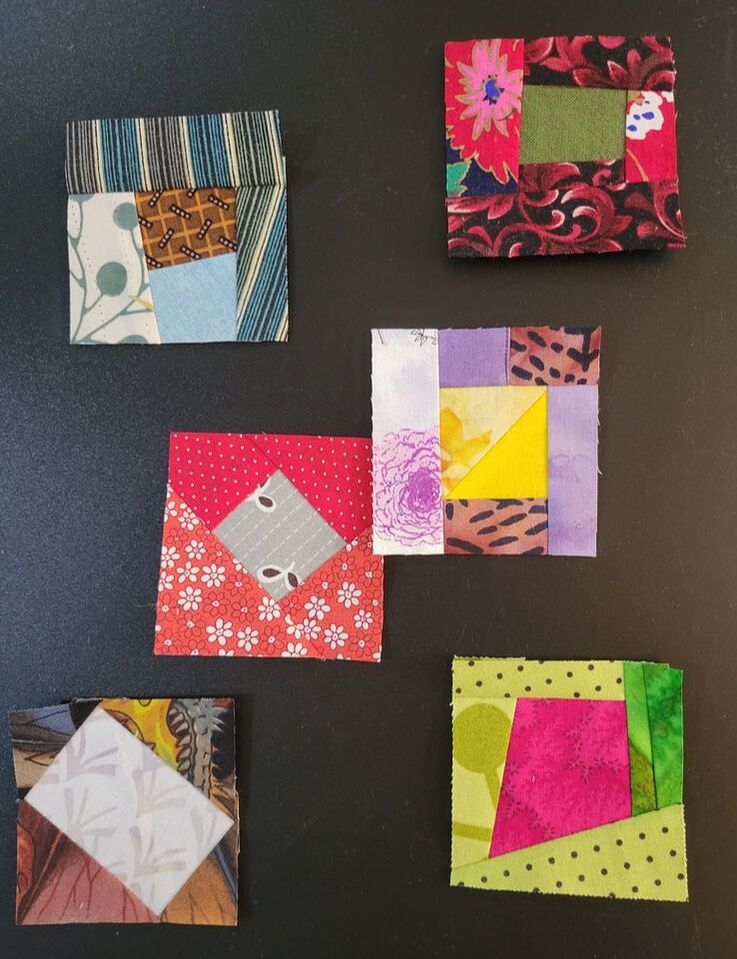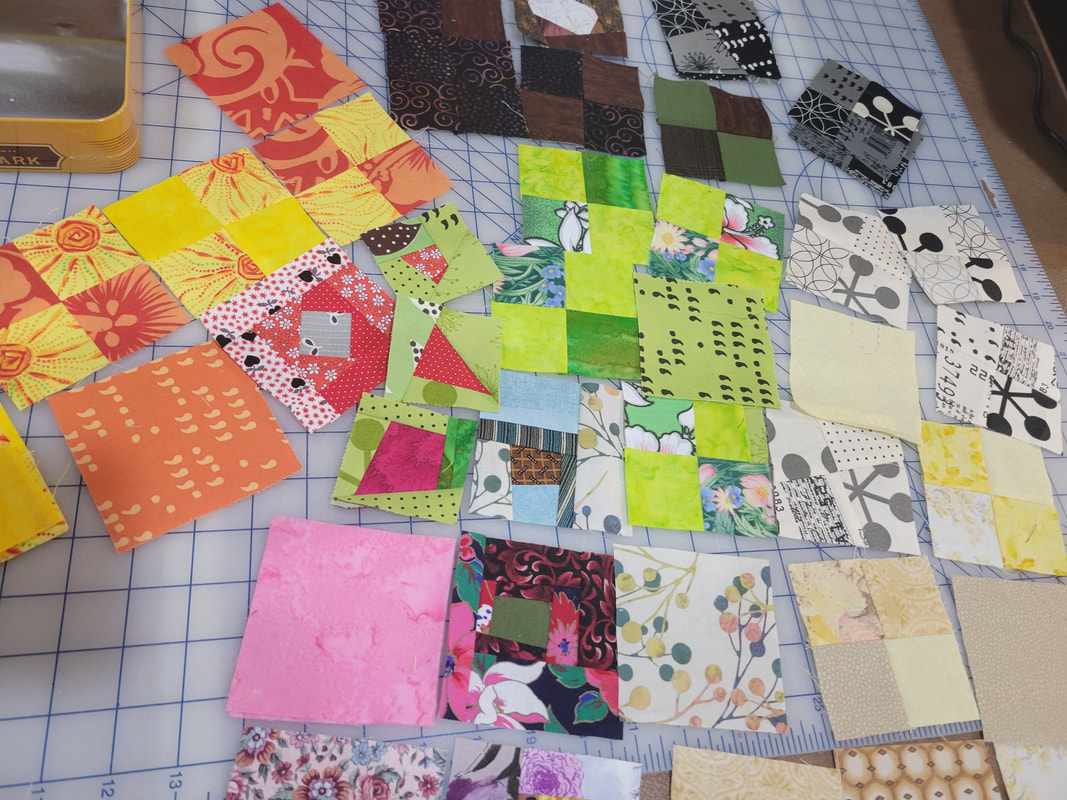|
Some quilts -- like my Memories of Africa Quilt or my Dandelion quilt -- start with a plan. I sit down and draw an idea, pick my fabrics, and work my way toward a fore-visioned end. I love working like that, because I can bring an idea into reality! But those quilts tend to be thinky quilts, and sometimes I don't have the reserves to think my way through my hobby. Lately, I've been getting home from work at 6:30pm, and it's dark, and I have just enough space in my brain for a little Foundation Paper Piecing... before I feel my focus slip, like a car falling out of gear. I get maybe a half-hour of concentration, and then I find myself picking the wrong fabric for the pattern and having to rip seams, or just staring at the same piece for a while doing nothing. I desire to be creative, but sewing to a plan leads to frustration. That's why I like to have a second project at the same time, a non-thinky project. The Acid Trip, Scrappy Double Wedding Ring, and today's featured project are all examples of what I think of as "blank verse" projects. BLANK VERSE Blank verse, not to be confused with free verse, is an English language poetic form where the poet can take any subject, and any register, and any vocab choice, and write anything at all, as long as it's in iambic pentameter. For the non-poetry-geeks, iambic pentameter is when the rhythm of the language sounds like this: and ONE and TWO and THREE and FOUR and FIVE The meter called iambic simply means a softer sound is followed by a loud. Pentameter -- just break the word apart: five "iambs" in a row the poet writes. It's super easy for the words to fall iambic'ly. It's not a strain at all. Obviously, if every single line is perfectly iambic, the poem starts to sound like a metronome, which is why even if they're mostly using blank verse, poets strategically break the rule every now and then. They might use a change in meter to suggest a surprise, or change of pace, or a lie. Consider Hamlet, Act 1 Scene 3. Laertes, a young man, is about to leave for school. In parting, he advises his sister not to take the prince's flirtations too seriously, because young men are fickle, and girls' hearts (and reputations) easy to break. Read his advice, and you'll find his meter starts iambic, but varies. Sometimes he speaks in a different rhythm, to emphasize how genuine his speech is. Read the following bit aloud and notice how "chaste treasure" and "Fear it" jumps out at you because they're not iambic: If with too credent ear you list his songs, Though the feet vary a bit, there are still five feet in each line. This is blank verse done well. BLANK VERSE PROJECTS How do I apply this to quilting? Since blank verse only has two rules (use iambs and use five of them), it's astonishingly varied in how it turns out. Shakespeare's blank verse and Robert Frost's blank verse are world's apart. So, when I need a less-thinky quilting project, I think of a few sewing or design rules, and let myself range far and wide within those bounds. For my Acid Trip quilt, my rules were "light stripe in the middle and dark to the edges" and from there I just put whatever colors together that I liked. My pieces ended up being analogous color schemes, because my eye likes that, but I could've done high-contrast complementary color schemes and still been within my rule. As I went on, I strategically broke my rule a few times (the black rectangles for eye-rest), just as a poet may strategically break meter. For the Double Wedding Ring quilt, though it's a traditional pattern, it's also just a template. I can fill in the melon slices any way I want, as long as I trim them to the right shape in the end. I find it relaxing to do, because I can't make a mistake, as long as I follow the one rule. I have seen scrap quilts where there's no rule at all. The quilter tosses scraps from other projects into a box, unsorted by color or size, and grabs them at random, putting pieces together and so-on until the quilt is done. I dislike those quilts, because they look like confetti or litter to me. I prefer to have some structure or rule, if only one, to guide the chaos. Right now, having finished Acid Trip, I need a new blank verse project. I find my inspiration on YouTube. INSPIRATION Terry Rowland has a video instructional about her "Color Wash Quilt", a real stashbuster. She sets a few constraints: the size of the block, and its general construction method (a center scrap surrounded by complementary colors). Then she makes a whole bunch and plays with them. She has a prescribed way she sews the borders around the center scrap, so she can rotate each block to avoid seam clutter. She might have other rules, but I'm not sure because once I fall in love with the quilt, I stop watching the video. I don't want to copy her exactly; I just want to take the fun inspiration and run with it! So I make myself a few rules:
This project will run in the background for a while, as I work on other things concurrently, but perhaps in a year or so I'll be happily posting about Gustav's Jewel Box coming together at last!
1 Comment
The Sister
2/4/2023 02:52:49 pm
What a charming name… the piecemeal does remind me of Klimt’s work. I glazed over a bit when you explained the poetry side of things, but I do understand where you’re coming from and how you’re carrying the blank verse concept into this hobby.
Reply
Leave a Reply. |
Karen Roy
Quilting, dressmaking, and history plied with the needle... Sites I EnjoyThe Quilt Index Categories
All
Archives
March 2024
|



 RSS Feed
RSS Feed